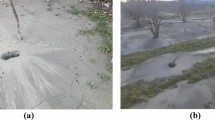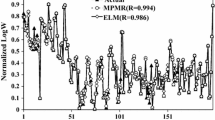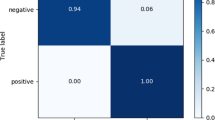Abstract
This article focuses on the application of extreme learning machine (ELM) for prediction of liquefaction susceptibility of soil based on cone penetration test data. The determination of liquefaction susceptibility of soil has been taken as a classification problem. ELM predicts liquefaction susceptibility of soil based on earthquake magnitude (M), cone resistance (qc), mean grain size (D50), total vertical stress (σ0), effective vertical stress (σ′0), normalized peak horizontal acceleration at ground surface (α/g), cyclic stress ratio \(\left( {\frac{\tau }{{\sigma^{\prime}_{0} }}} \right)\). Six models have been developed. The results of ELM have been compared with the artificial neural network models. This study shows that the developed ELM is a potential robust method for solving different problems in geotechnical engineering.
Similar content being viewed by others
Explore related subjects
Discover the latest articles, news and stories from top researchers in related subjects.Avoid common mistakes on your manuscript.
1 Introduction
In view of the rising number of earthquakes in the recent past, the determination of liquefaction susceptibility of soil is an important task in geotechnical earthquake engineering. Liquefaction causes severe loss to life and property due to sinking/overturning of buildings, ground cracking and sand blows. Geotechnical engineers use several in situ {Standard Penetration Test (SPT), cone penetration test (CPT) and Shear wave velocity} based techniques for determination of liquefaction susceptibility of soil (Seed and Idriss 1967, 1971; Seed et al. 1983, 1984; Robertson and Campanella 1985; Seed and De Alba 1986; Stark and Olson 1995; Olsen 1997; Robertson and Wride 1998; Dobry et al. 1981; Seed et al. 1983; Stokoe et al. 1988a; Tokimatsu and Uchida 1990; Andrus et al. 1999 and Andrus and Stokoe 2000). Every method has limitations. Geotechnical engineers successfully use artificial neural network (ANN) for determination of liquefaction susceptibility of soil (Goh 1994b, 1996; Agrawal et al. 1997; Najjar and Ali 1998; Ural and Saka 1998; Juang and Chen, 1999; Goh 2002; Javadi et al. 2006; Young and Byung Tak 2006; Goh and Goh 2007). However, ANN suffers from different drawbacks such as black box approach, arriving at local minima, low generalization capability, overtraining problem, etc. (Park and Rilett 1999; Kecman 2001).
This article examines the capability of extreme learning machine (ELM) for determination of liquefaction susceptibility of soil based on cone penetration test (CPT) data. This article adopts the database collect from the work of Goh (1996). The dataset contains information about earthquake magnitude (M), cone resistance (qc), mean grain size (D50), total vertical stress (σ0), effective vertical stress (σ′0), normalized peak horizontal acceleration at ground surface (α/g), cyclic stress ratio \(\left( {\frac{\tau }{{\sigma^{\prime}_{0} }}} \right)\) and status of soil during earthquake. ELM is sophisticated learning algorithm for single-hidden-layer feedforward neural network (SLFN; Huang et al. 2004a). It chooses input weights and hidden biases randomly. It adopts Moore–Penrose (MP) generalized inverse for calculating output weights. There are lots of applications of ELM in the literatures (Bharathi and Natarajan 2011; Balbay et al. 2012; Gao et al. 2013; Yang et al. 2014). The developed ELM has been compared with the ANN model developed by Goh (1996).
2 Details of ELM
This section will serve the methodology of ELM for prediction of liquefaction susceptibility of soil. ELM is developed by Huang et al. (2004b). Let us consider the following datasets (D):
where x is input, y is output and N is the number of datasets. Table 1 shows the different inputs for determination of liquefaction susceptibility of soil.In SLFN, the relation between x and y is given below:
where βi is the output weights from the hidden unit to the output units, wi is the hidden unit weights, L is the number of hidden nodes and g is the non-linear activation function. The above equation can be written in the following way.
where \(H = \left( {\begin{array}{*{20}c} {g\left( {w_{1} x_{1}^{T} + b_{1} } \right)} & \cdots & {g\left( {w_{m} x_{1}^{T} + b_{m} } \right)} \\ \vdots & \ddots & \vdots \\ {g\left( {w_{1} x_{n}^{T} + b_{1} } \right)} & \cdots & {g\left( {w_{m} x_{n}^{T} + b_{m} } \right)} \\ \end{array} } \right)\), \(\beta = \left( {\beta_{1} , \ldots ,\beta_{m} } \right)^{T}\) and \(y = \left( {y_{1} , \ldots ,y_{n} } \right)^{T}\).
The value of β is determined by solving the following equation.
where H−1 is the Moore–Penrose inverse of H (Rao and Mitra 1971).
In ELM, the datasets have been divided into the following two groups:
Training Dataset: This is used to develop the ELM. This article uses the same training datasets as used by Goh (1994b).
Testing Dataset: This is used to verify the developed ELM. This article adopts the same testing dataset as used by Goh (1994b).
The datasets are normalized between 0 and 1. The program of ELM has been developed by using MATLAB.
3 Results and Discussion
For developing the ELM, radial basis function has been adopted as activation function. Different number of hidden neurons have been tried to get best performance. The performance of ELM has been determined by using the following equation.
For a good model, the value of performance should be close to one. Table 2 shows the performance of different models and number of hidden neurons. From Table 2, it is clear that
MODEL I,III and V give best testing performance. MODEL IV gives the best training performance. However, the performance of testing dataset of MODEL IV is not good. A comparative study has been carried out between the developed ELM and ANN models. Comparison has been carried out for testing dataset. The performance of MODEL II and IV is not good. Table 3 shows the comparison. It is clear from Table 3 that the developed ELM outperforms the ANN. ELM has minimum human intervention compare to the ANN. The developed ELM is very fast. The major advantage of ELM is that all parameters of ELM are determined analytically. ELM uses only one tuning parameter. However, ANN uses many tuning parameters.
4 Conclusions
This article describes ELM for prediction of liquefaction susceptibility of soil based on CPT data. Five models have been developed. The developed ELM shows excellent performance. The results show that the developed ELM successfully captured the relationship between soil parameters and earthquake parameters for determination of liquefaction susceptibility of soil. It gives better performance than the ANN model. The developed ELM can be used as a quick tool for determination of liquefaction susceptibility of soil. Our experimental results show that the developed ELM is a robust model for prediction of liquefaction susceptibility of soil.
References
Agrawal G, Chameau JA, Bourdeau PL (1997) Assessing the liquefaction susceptibility at a site based on information from penetration testing. In: Kartam N, Flood I, Garrett JH (eds) Artificial neural networks for civil engineers fundamentals and application. Academic Press, New York, pp 185–214
Andrus RD, Stokoe KH (2000) Liquefaction resistance of soils from shear wave velocity. J Geotech Geoenviron Eng ASCE 126(11):1015–1025
Andrus RD, Stokoe KH, Chung RM (1999) Draft guidelines for evaluating liquefaction resistance using shear wave velocity measurements and simplified procedure, NISTIR 6277. Natl Inst Stand Technol, Gaithersburg
Balbay A, Avci E, Sahin O et al (2012) Modeling of drying process of bittim nuts (Pistacia terebinthus) in a fixed bed dryer system by using extreme learning machine. Int J Food Eng 84(4):1–16
Bharathi A, Natarajan AM (2011) Efficient classification of cancer using support vector machines and modified extreme learning machine based on analysis of variance features. Am J Appl Sci 8(12):1295–1301
Dobry R, Stokoe KH, Ladd RS et al (1981) Liquefaction susceptibility from S-wave velocity, In: Proceedings of the ASCE national convention. In situ tests to evaluate liquefaction susceptibility, ASCE, New York
Gao F, Li H, Xu B (2013) Applications of extreme learning machine optimized by ICPSO in fault diagnosis. Zhongguo Jixie Gongcheng/China Mech Eng 24(20):2753–2757
Goh ATC (1994a) Seismic liquefaction potential assessed by neural networks. J Geotech Eng 120(9):1467–1480
Goh ATC (1994b) Nonlinear modelling in geotechnical engineering using neural networks. Aust Civil Eng Trans CE 36(4):293–297
Goh ATC (1994c) Seismic liquefaction potential assessed by neural network. J Geotech Geoenviron Eng 120(9):1467–1480
Goh ATC (1996) Neural-network modeling of CPT seismic liquefaction data. J Geotech Eng 122(1):70–73
Goh ATC (2002) Probabilistic neural network for evaluating seismic liquefaction potential. Can Geotech J 39:219–232
Goh ATC, Goh SH (2007) Support vector machines. Their use in geotechnical engineering as illustrated using seismic liquefaction data. Comput Geotech 34(5):410–421
Huang GB, Zhu QY, Siew CK (2004a) Extreme learning machine a new learning scheme of feed forward neural networks. In: Proceedings of the international joint conference on neural networks (IJCNN2004), Budapest, Hungary
Huang GB, Zhu QY, Siew CK (2004b) Extreme learning machine in technical report ICIS/03/2004. School of electrical and electronic engineering, Nanyang Technological University, Singapore
Javadi AA, Rezania M, Mousavi Nezhad M (2006) Evaluation of liquefaction induced lateral displacements using genetic programming. Comput Geotech 33:222–233
Juang CH, Chen CJ (1999) CPT-based liquefaction evaluation using artificial neural networks. Comput Aided Civil Infrastruct Eng 14(3):221–229
Kecman V (2001) Learning and soft computing support vector machines neural networks, and fuzzy logic models. MIT press, Cambridge
Najjar YM, Ali HE (1998) CPT-based liquefaction potential assessment. A neuronet approach. Geotech Spec Publ ASCE 1:542–553
Olsen RS (1997) Cyclic liquefaction based on the cone penetrometer test. In: Youd TL, Idriss I M (eds) National center for earthquake engineering research, Proceedings of the NCEER workshop on evaluation of liquefaction resistance of soils, Tech. Rep. NCEER-97-0022, Buffalo, pp 225–276
Park D, Rilett LR (1999) Forecasting freeway link travel times with a multi-layer feed forward neural network. Comput Aided Civil InfraStruct Eng 14:358–367
Rao CR, Mitra SK (1971) Generalized inverse of matrices and its applications. Wiley, New York, p 240
Robertson PK, Campanella RG (1985) Liquefaction potential of sands using the CPT. J Geotech Eng 111:384–403
Robertson PK, Wride CE (1998) Evaluating cyclic liquefaction potential using the cone penetration test. Can Geotech J 35(3):442–459
Seed HB, De Alba P (1986) Use of SPT and CPT tests for evaluating the liquefaction resistance of sands, use of in situ tests in geotechnical engineering, Geotechnical Special Publication 6, ASCE
Seed HB, Idriss IM (1967) Analysis of soil liquefaction Niigata earthquake. J Soil Mech Found Div ASCE 93(3):83–108
Seed HB, Idriss IM (1971) Simplified procedure for evaluating soil liquefaction potential. J Soil Mech Found Div ASCE 97(9):1249–1273
Seed HB, Idriss IM, Arango I (1983) Evaluation of liquefaction potential using field performance data. J Geotech Eng Div ASCE 109(3):458–482
Seed HB, Tokimatsu K, Harder LF et al (1984) Influence of SPT procedures in soil liquefaction resistance evaluation, Rep. No. UCB/EERC-84/15, earthquake Engrg. Res. Ctr., University of California, Berkeley, California
Stark TD, Olson SM (1995) Liquefaction resistance using CPT and field case histories. J Geotech Eng ASCE 121(12):856–869
Stokoe KH, Nazarian S, Rix GJ et al (1988a) In situ seismic testing of hard-to-sample soils by surface wave method. In: Von Thun JL, (ed) Earthquake engineering and soil dynamics II—recent advances in ground-motion evaluation. Geotechnical Special Publication, vol 20. ASCE, New York, pp 264–289
Tokimatsu K, Uchida A (1990) Correlation between liquefaction resistance and shear wave velocity. Soils Found 30(2):33–42
Ural DN, Saka H (1998) Liquefaction assessment by neural networks. Electron J Geotech Eng http://geotech.civen.okstate.edu/ejge/ppr9803/index.html
Yang H, Yi D, Zhao J et al (2014) Distributed optimal dispatch of virtual power plant based on elm transformation. J Ind Manag Optim 10(4):1297–1318
Young SuK, Byung Tak K (2006) Use of artificial neural networks in the prediction of liquefaction resistance of sands. J Geotech Geoenviron Eng 132(11):1502–1504
Author information
Authors and Affiliations
Corresponding author
Rights and permissions
About this article
Cite this article
Samui, P., Jagan, J. & Hariharan, R. An Alternative Method for Determination of Liquefaction Susceptibility of Soil. Geotech Geol Eng 34, 735–738 (2016). https://doi.org/10.1007/s10706-015-9969-2
Received:
Accepted:
Published:
Issue Date:
DOI: https://doi.org/10.1007/s10706-015-9969-2




